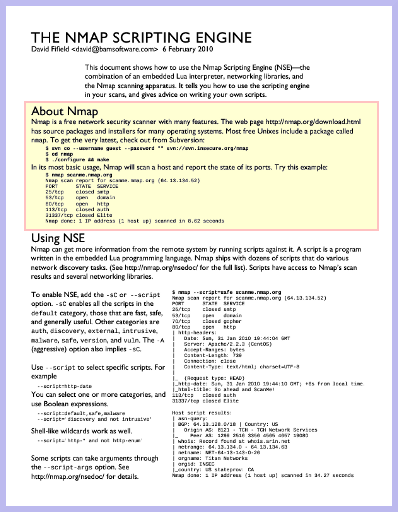
Audience handout: http://www.bamsoftware.com/talks/fosdem-2010.pdf.

The Nmap web site is http://nmap.org/.
Download from http://nmap.org/download.html.
$ nmap scanme.nmap.org Starting Nmap 5.21 ( http://nmap.org ) at 2010-01-31 19:40 MST Nmap scan report for scanme.nmap.org (64.13.134.52) Host is up (0.078s latency). Not shown: 994 filtered ports PORT STATE SERVICE 25/tcp closed smtp 53/tcp open domain 70/tcp closed gopher 80/tcp open http 113/tcp closed auth 31337/tcp closed Elite Nmap done: 1 IP address (1 host up) scanned in 9.19 seconds
NSE is a combination of the Lua programming language, networking libraries, and Nmap. It can be thought of as a kind of extended version detection that can carry on protocol negotiations or do anything else that can be programmed. It is suitable for rapid exploit research and development (both detection and exploitation).
$ nmap -sC scanme.nmap.org Starting Nmap 5.21 ( http://nmap.org ) at 2010-01-31 19:47 MST Nmap scan report for scanme.nmap.org (64.13.134.52) Host is up (0.070s latency). Not shown: 994 filtered ports PORT STATE SERVICE 25/tcp closed smtp 53/tcp open domain 70/tcp closed gopher 80/tcp open http |_html-title: Go ahead and ScanMe! 113/tcp closed auth 31337/tcp closed Elite Nmap done: 1 IP address (1 host up) scanned in 26.98 seconds
$ nmap --script=safe scanme.nmap.org Starting Nmap 5.21 ( http://nmap.org ) at 2010-01-31 19:43 MST Nmap scan report for scanme.nmap.org (64.13.134.52) Host is up (0.073s latency). Not shown: 994 filtered ports PORT STATE SERVICE 25/tcp closed smtp 53/tcp open domain 70/tcp closed gopher 80/tcp open http |_html-title: Go ahead and ScanMe! | http-headers: | Date: Mon, 01 Feb 2010 02:44:20 GMT | Server: Apache/2.2.3 (CentOS) | Accept-Ranges: bytes | Content-Length: 739 | Connection: close | Content-Type: text/html; charset=UTF-8 | |_ (Request type: HEAD) |_http-date: Mon, 01 Feb 2010 02:44:26 GMT; +11s from local time. 113/tcp closed auth 31337/tcp closed Elite Host script results: |_asn-query: No Answers | whois: Record found at whois.arin.net | netrange: 64.13.134.0 - 64.13.134.63 | netname: NET-64-13-143-0-26 | orgname: Titan Networks | orgid: INSEC |_country: US stateprov: CA Nmap done: 1 IP address (1 host up) scanned in 35.40 seconds
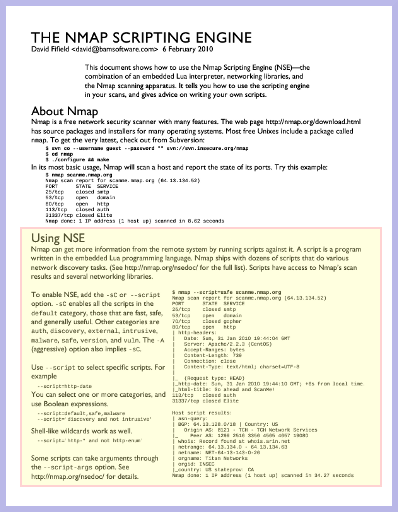
nmap -sC nmap --script=default nmap -A
nmap --script=ssh-hostkey nmap --script='http-*,snmp-*'
nmap --script=safe,default,malware
nmap --script='(default or discovery) and not intrusive' nmap --script='smb-* and not smb-brute'
Scripts may be in one or more categories. http://nmap.org/nsedoc/
authdefault-sC. Generally safe, fast, and useful.discoveryexternalintrusivemalwaresafeintrusive: fast, polite, unobtrusive.vulnversion-sV.nmap --script=ssh-hostkey --script-args ssh_hostkey=all nmap --script=snmp-sysdescr --script-args snmpcommunity=test1 nmap --script=pjl-ready-message --script-args 'pjl_ready_message="TAKE ME TO YOUR LEADER"' nmap --script=smb-server-stats --script-args smbuser=admin,smbpass=password1
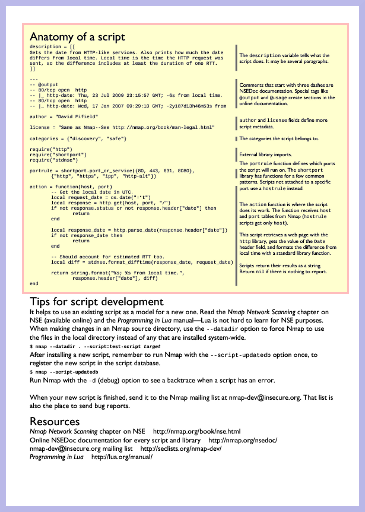
description = [[
Gets the date from HTTP-like services. Also prints how much the date
differs from local time. Local time is the time the HTTP request was
sent, so the difference includes at least the duration of one RTT.
]]
---
-- @output
-- 80/tcp open http
-- |_ http-date: Thu, 23 Jul 2009 23:15:57 GMT; -6s from local time.
-- 80/tcp open http
-- |_ http-date: Wed, 17 Jan 2007 09:29:10 GMT; -2y187d13h46m53s from local time.
author = "David Fifield"
license = "Same as Nmap--See http://nmap.org/book/man-legal.html"
categories = {"discovery", "safe"}
require("http")
require("shortport")
require("stdnse")
portrule = shortport.port_or_service({80, 443, 631, 8080},
{"http", "https", "ipp", "http-alt"})
action = function(host, port)
-- Get the local date in UTC.
local request_date = os.date("!*t")
local response = http.get(host, port, "/")
if not response.status or not response.header["date"] then
return
end
local response_date = http.parse_date(response.header["date"])
if not response_date then
return
end
-- Should account for estimated RTT too.
local diff = stdnse.format_difftime(response_date, request_date)
return string.format("%s; %s from local time.",
response.header["date"], diff)
end
descriptioncategoriesportrule/hostruleactionportrule and hostrule scriptsbanner.nse--- -- Script is executed for any TCP port. portrule = function( host, port ) return port.protocol == "tcp" end action = function( host, port )
asn-query.nse--- -- This script will run for any non-private IP address. hostrule = function( host ) return not ipOps.isPrivate( host.ip ) end action = function( host )
local socket = nmap.new_socket()
-- These look like blocking calls to the script,
-- but other scripts get to run while they execute.
socket:connect(host.ip, port.number, port.protocol)
socket:send("USER anonymous\r\n")
socket:send("PASS IEUser@\r\n")
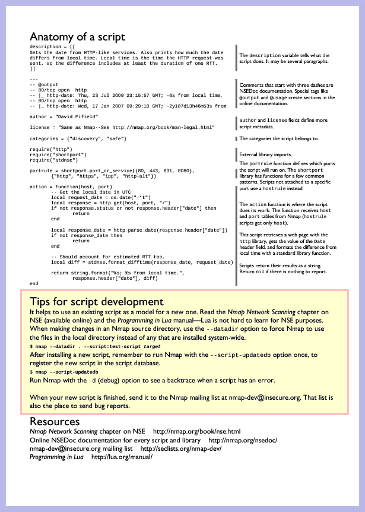
nse_main.lua — main engine, itself written in Lua.nselib/*.lua — NSE libraries. Examples are dns.lua, http.lua, snmp.lua.nse_*.cc — Lua-to-C++ interfaces. Some libraries, like openssl and bit, are written in C++ with a Lua wrapper.scripts/script.db — the script database that maps
script names to categories.
nmap --datadir .uses files in the local directory instead of those in
/usr/share/nmap.
Don't forget to run
nmap --script-updatedbor the script won't be selectable except by file name.
Use -d for backtraces:
./scripts/ssl-cert.nse:155: attempt to perform arithmetic on a nil value
stack traceback:
./scripts/ssl-cert.nse:155: in function 'stringify_name'
./scripts/ssl-cert.nse:110: in function <./scripts/ssl-cert.nse:84>
(tail call): ?
Write to nmap-dev@insecure.org. For example:
http://seclists.org/nmap-dev/2009/q4/508Patrik Karlsson: I finished two more Nmap scripts that hopefully will be of more use than the first one. nfs-showmount.nse replicates the functionality of showmount -e in order to list remote NFS shares. citrix-published-applications.nse queries Citrix (1604/udp) for the list of published applications.http://seclists.org/nmap-dev/2009/q4/529David Fifield: I have only one concern from looking at the scripts, and that is the undocumented packet contents. You need to add comments explaining what all those hex digits mean, and links to references if available.http://seclists.org/nmap-dev/2009/q4/537Patrik Karlsson: Ok, so I've made an attempt to clean up and document the script(s). There is little documentation on this protocol or at least that I can find. I have documented the bits and bytes I am using when processing the response and the bytes I was able to figure out in the packets that are sent.http://seclists.org/nmap-dev/2009/q4/535David Fifield: I added your script in r16210. Well done!
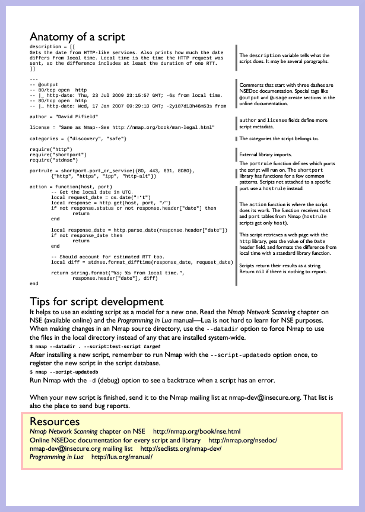
From http://nmap.org/nsedoc/scripts/http-favicon.html:
Gets the favicon ("favorites icon") from a web page and matches it against a database of the icons of known web applications. If there is a match, the name of the application is printed; otherwise the MD5 hash of the icon data is printed.
A chance to scan! From favicon-survey.nse (not included
with Nmap):
Gets favicons and makes a database with their frequencies. The script downloads each favicon it finds and stores it in a file in ICON_DIR named after the MD5 hash of the favicon. $ cd ~/favicon $ ls icon 17F03417CBF92B80992B7CA7A566FB0C.ico C89ECD7675567625E5755A7A9C31632D.ico 379A65BEB4D412765FCF9FBBDEECD416.ico C8BFCB5728998AC6C3DA90EA5CD2340A.ico 7131EF7073ED685BF2987B9061C65D36.ico CB5AA723DDDB0734CEC459F2B9C3B1C4.ico 88733EE53676A47FC354A61C32516E82.ico D16A0DA12074DAE41980A6918D33F031.ico A3C7BE1BCF382EA413C30453A4ACF638.ico D41D8CD98F00B204E9800998ECF8427E.ico A8FE5B8AE2C445A33AC41B33CCC9A120.ico D4DA62A788942AAB81D033C9E49D57CB.ico B6141EFEE8D8E64DBC23539F99F7238E.ico ECF508711C226CCDA02D58853B31D7A7.ico C3FB27F0BF8AC3171C8105726D61380A.ico It also stores the host name and port of each host that had a favicon in a file in HASH_DIR, also named with the MD5 sum.
The result:
# These are the most common icons from a scan of all dmoz sites in January # 2010. Icons are listed in decreasing order by frequency. # Commented-out lines are those that are too broad to be useful in # identification. # D41D8CD98F00B204E9800998ECF8427E: empty file 9CEAE7A3C88FC451D59E24D8D5F6F166: Parallels Plesk Panel 63B982EDDD64D44233BAA25066DB6BC1: Joomla! CMS DCEA02A5797CE9E36F19B7590752563E: Parallels Plesk Panel 64CA706A50715E421B6C2FA0B32ED7EC: Parallels Plesk Panel 6C4EC806C82AB04D6B7D857E6FB68F95: Doteasy web hosting 1CE0C63F8BD1E5D3376EC0AE95A41C08: Parallels Plesk Panel # ECAA... is a UTF-8 byte order mark, so may be more general. ECAA88F7FA0BF610A5A26CF545DCD3AA: Demand Media domain parking 5B0E3B33AA166C88CEE57F83DE1D4E55: DotNetNuke CMS
What do you do with a million tiny icons?
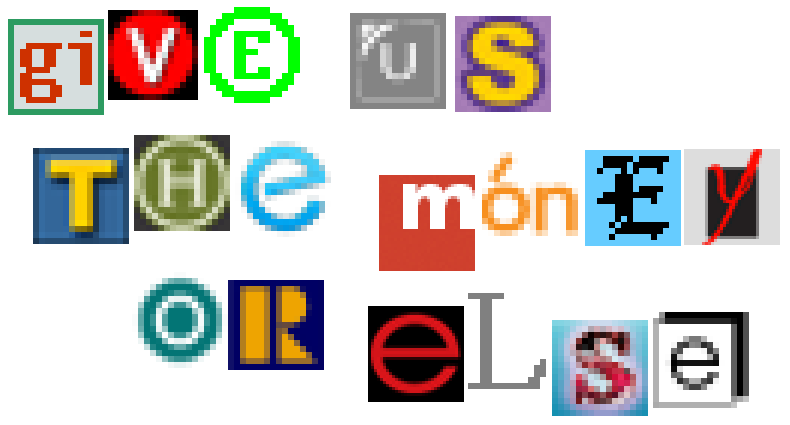

More information at http://nmap.org/favicon/.
David Fifield
david@bamsoftware.com
nmap.org
nmap-dev@insecure.org